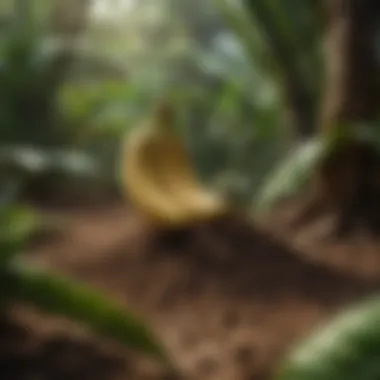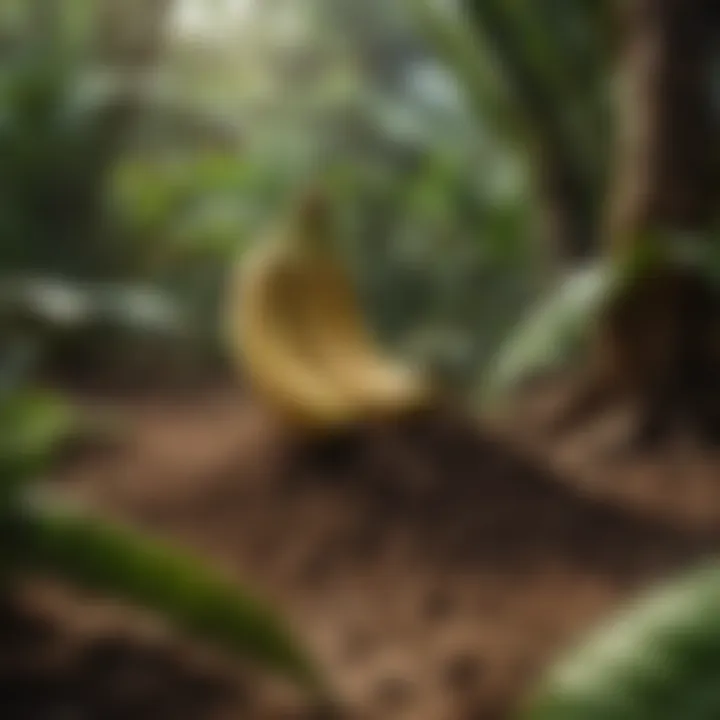Essential Fertilizing Techniques for Banana Trees


Intro
Fertilizing bananas is a critical aspect of growing this tropical fruit effectively. Banana trees are known for their lush foliage and rich fruit production. However, simply planting a banana tree is not enough to ensure its health and productivity. Proper fertilization is key to unlocking the full potential of these plants. This section aims to provide insights into the necessary nutrients and fertilization techniques that cater to the unique demands of banana trees.
Growing bananas requires an understanding of their nutritional needs. These trees thrive on potassium, nitrogen, and phosphorus. Each of these nutrients plays a specific role in the growth and fruiting process. For instance, potassium is essential for developing fruit size and quality, while nitrogen influences leaf growth.
Understanding how to effectively fertilize your banana tree can lead to abundant fruit yields. This guide will also examine environmental factors that influence fertilization practices, ensuring that both novice and experienced gardeners can achieve the best results.
Here, we will elaborate on various methods of fertilization, including organic options and synthetic products. By focusing on evidence-based practices, readers will be prepared to cultivate a healthy and productive banana tree, no matter the growing conditions.
Understanding the Nutritional Needs of Banana Trees
Understanding the nutritional needs of banana trees is critical for successful cultivation. Banana trees require a balanced supply of nutrients to thrive and produce fruit. Recognizing these needs leads to better growth, enhanced fruit quality, and increased yields. As banana trees are heavy feeders, knowing what nutrients are essential helps gardeners optimize their fertilization practices. This section explores the key nutrients and their roles, providing a foundational knowledge crucial for effective fertilization.
Key Nutrients for Optimal Growth
Nutrients are broadly categorized into macronutrients and micronutrients. Each plays a distinct role in the growth and development of banana trees.
Macronutrients: Nitrogen, Phosphorus, Potassium
Macronutrients are fundamental for the growth of banana trees, with nitrogen, phosphorus, and potassium being notably significant.
- Nitrogen promotes leaf growth and vibrant green foliage. It is essential during the tree's vegetative stage.
- Phosphorus is vital for root development and flowering. It supports energy transfer within the plant, which is crucial when the tree transitions to its reproductive phase.
- Potassium helps in fruit development and enhances the tree's overall resistance to diseases.
The key characteristic of these macronutrients is their role in metabolism and energy transfer. They are considered a beneficial choice for ensuring healthy growth and prolific fruiting. However, it is essential to provide them in the correct ratios to avoid nutrient imbalances, which can hinder growth or cause environmental harm.
Micronutrients: Calcium, Magnesium, and Iron
Micronutrients, though required in smaller amounts, play a vital role in the health of banana trees. Calcium, magnesium, and iron are particularly noteworthy.
- Calcium aids in cell wall structure and protects against diseases.
- Magnesium is crucial for photosynthesis, boosting the tree's ability to convert sunlight into energy.
- Iron supports chlorophyll production, impacting the tree's ability to sustain growth and health.
These micronutrients are advantageous because they facilitate essential biochemical processes. Their unique features lie in their involvement in enzyme activation and nutrient absorption. Deficiencies in these micronutrients can lead to significant health issues for banana trees, affecting both growth and yield.
"Understanding the nutritional needs of banana trees ensures that gardeners can provide a balanced diet, promoting healthy growth and abundant fruit production."
In summary, both macronutrients and micronutrients are essential for the optimal growth of banana trees. By recognizing these nutritional aspects, gardeners can make informed decisions about what fertilizers to use and how to apply them, ultimately leading to more productive and resilient plants.
Types of Fertilizers for Banana Trees
Fertilization plays a critical role in the health and productivity of banana trees. Choosing the right type of fertilizer can significantly influence growth, fruit yield, and overall plant vitality. The selection between organic and inorganic fertilizers directly impacts not just the banana tree itself but also the surrounding environment. This section delves into these different types of fertilizers, shedding light on their specific elements, benefits, and considerations.
Organic vs. Inorganic Fertilizers
When it comes to promoting the growth of banana trees, understanding the difference between organic and inorganic fertilizers is essential. Organic fertilizers are derived from natural sources such as animal manure, compost, and plant materials. They enhance soil health over time, improving its structure and water retention capacity. This natural approach can lead to sustainable plant growth because it encourages a diverse microbial ecosystem conducive to nutrient cycling.
Benefits of Organic Fertilizers
Organic fertilizers offer several key benefits that make them a popular choice among gardeners. One of the main advantages is the ability to improve soil quality. They add organic matter, which promotes better water retention and aeration. This is especially important for banana trees that thrive in rich, well-drained soils. Additionally, organic fertilizers release nutrients slowly, providing a more gradual supply that aligns well with the trees’ growth cycles.
They are also environmentally friendly, reducing the risk of water pollution from runoff.
Advantages of Inorganic Fertilizers
In contrast, inorganic fertilizers consist of synthesized chemicals. Their main advantage lies in their immediate availability of nutrients. They can provide a quick boost to a banana tree's growth, especially during critical growing periods. This characteristic makes them particularly useful for addressing specific nutrient deficiencies in soils that have been over-farmed or depleted. However, the downside is that improper use can lead to soil degradation over time, as these fertilizers do not enhance soil structure like organic alternatives.
Slow-Release vs. Fast-Release Fertilizers
Another crucial aspect in fertilizing banana trees is understanding how different fertilizer release rates impact nutrient availability. Choosing between slow-release and fast-release fertilizers determines how and when nutrients are supplied to the plants, affecting their growth and fruiting performance.
Best Practices for Slow-Release Fertilizers
Slow-release fertilizers gradually release nutrients into the soil, providing a steady supply over an extended period. This is beneficial for banana trees as it aligns with their nutrient uptake patterns. Best practices include applying slow-release fertilizers at the beginning of the growing season. This method minimizes the risk of nutrient leaching during heavy rains. Moreover, slow-release fertilizers often use natural materials that contribute positively to soil health, further supporting the banana tree’s long-term growth.
Timing and Techniques for Fast-Release Fertilization
Fast-release fertilizers offer the immediate availability of nutrients, ideal for quick fixes in nutrient-deficient soils. The timing of application is crucial to maximize benefits without harming the tree. Applying these fertilizers during the early stages of growth or right before fruiting ensures that the tree has ample nutrients for vigorous growth. However, care should be taken to avoid excess use, as this can lead to nutrient burn, which is detrimental to the plant.
Fast-release fertilizers should be used sparingly and strategically to avoid damaging the banana tree.
Overall, understanding the types of fertilizers and their specific applications helps in nurturing banana trees effectively. This knowledge aids in making informed decisions that ultimately contribute to thriving banana plants.


Fertilization Timing for Banana Trees
Understanding the timing of fertilization is critical for the health and productivity of banana trees. Fertilizing at the right moment can significantly influence growth rates, fruit quality, and overall yield. Timing should align with the specific growth cycle of the banana tree, which is categorized into distinct phases. This synchronization enables the tree to absorb nutrients more efficiently, therefore promoting better growth and fruiting.
Understanding the Growth Cycle
Growth Stages: Vegetative vs. Reproductive
Banana trees experience two main growth stages: vegetative and reproductive. The vegetative stage is characterized by rapid leaf development and root establishment. During this phase, the focus is on producing robust foliage, which is essential for photosynthesis. Good nutrition during the vegetative stage boosts the plant's ability to store energy and prepare for flowering.
Contrasting this, the reproductive stage involves the flowering and fruiting process. Here, the banana tree requires different nutrients, primarily potassium, to support the development of clusters of bananas. Understanding these stages is vital when planning fertilization.
For example, applying a nitrogen-rich fertilizer during the vegetative stage can enhance leaf growth, while switching to potassium-based fertilizers during the reproductive phase will support fruit development. Effectively managing these two stages maximizes the tree’s potential for high yield.
Seasonal Considerations in Fertilizing
Seasonality plays a fundamental role in fertilizing banana trees. Weather patterns affect the growth cycle and, consequently, the timing of fertilization. Fertilizers can be less effective if applied during heavy rainfall, as leaching may occur, washing away nutrients before the tree absorbs them.
In tropical climates where banana trees thrive, there are often two main rainfall seasons. Fertilizing before the onset of the wet season can help prepare the soil and support nutrient uptake when moisture levels are high. This strategic timing helps to ensure that the nutrients are readily available when the tree is actively growing.
Another consideration is the tree’s response to temperature changes. Cooler nights or excessive heat may alter growth patterns. For instance, in colder months, the metabolic rates of trees decrease. Thus, a scaling back of fertilization during this time may be favorable.
In summary, recognizing and adapting to the growth cycle and seasonal variations leads to more effective fertilization strategies. By focusing on timing, gardeners can improve the outcomes of their fertilization practices, ultimately promoting healthier banana trees with higher productivity.
Application Techniques for Fertilizing Banana Trees
Fertilization techniques are crucial for the health and productivity of banana trees. Effective application methods can enhance nutrient availability and uptake by the plants. Each technique offers distinct benefits, and understanding them helps in making informed decisions that support vigorous growth and fruitful yields.
Surface Application Methods
Broadcasting Fertilizer
Broadcasting fertilizer involves spreading the fertilizer evenly over the soil surface. This method is particularly beneficial because it allows for a broad distribution of nutrients, helping to ensure that all parts of the root zone can access these essential elements. The key characteristic of broadcasting is its simplicity; it requires minimal tools and can be executed quickly.
Broadcasting helps in covering large areas efficiently, making it popular among both large-scale operations and home gardeners alike.
The unique feature of this technique is that it facilitates even nutrient distribution. However, there are disadvantages. If not done properly, some nutrients may wash away during heavy rains, leading to inefficiencies. Additionally, strict control of the amount applied is necessary to avoid over-fertilization.
Row Application Techniques
Row application techniques involve placing fertilizer in rows along the banana plants, near the root zones. This practice is critical because it places nutrients directly where they are most needed. Row application is often favored for its targeted approach, thus minimizing waste and potential harm to plants.
The key characteristic here is its precision. By applying fertilizer in rows, you can also monitor the exact amount used in a given area. Its unique feature lies in its ability to reduce nutrient runoff compared to broadcasting. One disadvantage is that it requires more time and labor, as it must be applied carefully and often needs repeated applications.
Soil Incorporation Techniques
Tilling and Mixing
Tilling and mixing involve integrating fertilizer into the soil through mechanical agitation. This method is crucial as it enhances nutrient availability by breaking up compacted soil, improving aeration, and facilitating root growth. The key benefit of this technique is its ability to enhance the effectiveness of fertilizers.
The unique feature of tilling and mixing is that it can also aid in weed suppression and improve soil structure. However, it has a disadvantage; excessive tilling can lead to soil degradation over time and disturb beneficial microorganisms in the soil.
Utilizing Mulch for Nutrient Retention
Utilizing mulch plays an important role in maintaining soil health and reducing water evaporation. Organic mulch, made from materials such as straw or wood chips, not only provides nutrients as it decomposes but also protects the soil from erosion and extreme temperature fluctuations.
The key characteristic of this technique is moisture retention, which is essential for banana trees. By covering the soil with mulch, you help to ensure that nutrients remain available longer. The unique feature of this method is its dual benefit: it reduces the need for frequent watering and contributes organic matter to the soil.
However, there are disadvantages. If not applied correctly, mulch can harbor pests or diseases. Also, it requires regular replenishment to maintain its effectiveness.
How to Monitor Fertilizer Effects
Monitoring the effects of fertilizer on banana trees is crucial for ensuring their optimal growth. Understanding nutrient uptake can directly affect fruit quality and yield. It is essential to recognize signs of deficiencies and excesses, which can inform necessary adjustments in fertilization practices. By utilizing effective monitoring methods, gardeners can stay proactive and responsive to the needs of their banana trees.
Signs of Nutrient Deficiencies
Recognizing nutrient deficiencies is essential in maintaining healthy banana trees. There are several specific signs to be aware of.
Yellowing Leaves and Stunted Growth
Yellowing leaves often indicate a nitrogen deficiency. This deficiency leads to stunted growth, which affects the tree's overall health. The key characteristic is that the leaves lose their vibrant green color and turn yellow, typically starting from the lower leaves.


This sign is crucial, as it serves as a clear, visible indicator that something is wrong with nutrient availability. In this article, understanding this phenomenon allows gardeners to take immediate action by adjusting their fertilization strategies.
Unique features of yellowing leaves include their potential to affect not only growth but also fruiting. An increase in nitrogen can provide quicker recovery, ensuring the plants return to optimal growth rates. However, applying too much nitrogen could lead to other issues, such as over-fertilization, which can also be harmful.
Fruiting Issues and Blossom Drop
Fruiting issues often arise due to a lack of potassium. The key characteristic of this problem involves premature blossom drop. When potassium levels are insufficient, the tree struggles to support fruit development, which can lead to a low yield.
Understanding this aspect is vital within the context of fertilizing banana trees. Blossom drop signifies not only a nutrient deficiency but also suggests that the overall balance of nutrients may be off. The unique feature here is that fruiting issues can present more complex challenges, as they involve not simply nutrient levels but also environmental conditions and tree health. By evaluating potassium levels in the soil, solutions often involve targeted fertilization strategies that address this specific nutrient while recognizing the critical balance needed for successful fruit set.
Soil Testing for Nutrient Levels
Soil testing is a necessary measure for monitoring nutrient levels effectively. This process can provide a clear picture of what elements are present or lacking. The significance of soil testing lies in its ability to guide fertilization practices based on real data rather than assumptions.
Frequency and Timing of Soil Tests
Regular soil testing is advised to keep track of nutrient levels. The recommended frequency varies based on the specific conditions in your area. Ideally, soil tests should be conducted at least once a year, preferably before the growing season. Testing at this time allows for informed decisions about nutrient amendments.
This approach is beneficial since it helps avoid both over-fertilization and under-fertilization. The unique feature of timely tests is that they can influence the entire fertilization strategy, allowing adjustments to be made before any significant issues arise. Ignoring the timing could lead to missed opportunities for correction and ultimately diminish plant health.
Interpreting Soil Test Results
Interpreting soil test results is a critical skill for any gardener. Understanding these results will directly contribute to effective fertilization strategies. The key characteristic of interpreting results involves recognizing the relevance of pH levels, macronutrient levels, and micronutrient concentrations. Each of these elements plays a role in the overall health of banana trees.
This aspect is beneficial as it allows for a targeted approach to fertilization. Unique features of this process provide insights into how soil amendments can correct deficiencies. Proper interpretation can lead to a well-balanced soil profile, enhancing the overall nutrient availability for banana trees. Conversely, misinterpretation could lead to misguided applications and, consequently, poor tree health and reduced yields.
Environmental Considerations in Fertilizing
Understanding the environmental factors that affect fertilizing banana trees is crucial. The right approach to fertilization can significantly influence plant health, growth, and production yield. By considering soil conditions and climate variations, growers can tailor their fertilization methods to ensure maximum nutrient utilization and minimize environmental impact.
Adapting to Soil Conditions
Sandy vs. Clay Soils
Soil texture plays a pivotal role in the effectiveness of fertilization for banana trees. Sandy soils, characterized by larger particles, have excellent drainage properties but can leach nutrients quickly. This means that while they allow for good water flow, they may require more frequent applications of fertilizers to replenish nutrient levels. Clay soils, conversely, are dense and retain nutrients well but may pose drainage issues, leading to a higher risk of over-fertilization and resulting in nutrient runoff.
Soil pH and its Influence on Nutrient Availability
The pH level of soil is a critical factor that impacts nutrient availability. Banana trees typically thrive in slightly acidic to neutral pH levels, around 6.0 to 7.0. When soil is too acidic or alkaline, certain nutrients become less available to plants. This can result in deficiencies that hinder tree growth and fruiting. Regular soil testing helps growers adjust pH levels, enabling better nutrient uptake and healthier plants.
Climate and Fertilization Strategy
Hot Climates vs. Tropics
Banana trees flourish in warm climates, but the subtleties between hot climates and tropical environments can affect fertilization strategies. In general, tropical climates offer consistent rainfall and humidity, supporting nutrient leaching and thus necessitating more frequent fertilization. Conversely, growers in hotter, more arid regions need to adapt their strategies to account for potentially lower moisture levels, often incorporating irrigation within their fertilization programs to ensure nutrients are effectively absorbed.
Adjusting Fertilizer Regimens for Rain Patterns
Seasonal rain patterns must be considered when planning fertilization schedules. During wet seasons, there is a likelihood of nutrient leaching, especially in sandy soils. Therefore, adjusting fertilizer application timings to precede dry spells can enhance nutrient retention. For growers in regions with unpredictable rainfall, a more flexible approach is recommended, allowing for adjustments to fertilizer type and application based on immediate weather conditions. This aids in maximizing nutrient availability and minimizes wastage due to runoff.
Effective fertilization must consider both soil characteristics and weather patterns to ensure healthy banana trees.
Common Mistakes in Banana Tree Fertilization
Fertilizing banana trees effectively requires knowledge, but many gardeners still commit common errors. Understanding these mistakes is essential to ensure healthy growth and fruitful yields. This section highlights frequent oversights encountered in banana tree fertilization, such as over-fertilization and under-fertilization. Becoming aware of these issues will aid in avoiding costly setbacks that can affect both plant health and fruit production.
Over-fertilization Consequences
Over-fertilization is a key concern when nurturing banana trees. It occurs when an excess of fertilizers is applied, leading to detrimental effects on the plant. One prominent symptom is fertilizer burn, which can cause significant physical damage to the leaves and overall plant vitality.
Symptoms of Fertilizer Burn
Fertilizer burn manifests through darkened leaf edges and curling of leaf tips. It indicates that the concentration of nutrients has become too high for the plant to absorb efficiently. The extent of this damage contributes greatly to the overall health of the banana tree. Affected plants often exhibit stunted growth and may produce fewer fruits.
The key characteristic of fertilizer burn is its visibility on the plant, making it a helpful indicator for gardeners. By watching for the signs, gardeners can respond quickly before the tree experiences further damage. This topic is beneficial for understanding how to calibrate fertilizer use effectively.
However, over-fertilization results in more than just immediate visible damage. It can create long-term challenges that affect soil ecosystems and future growth potential. When tree roots absorb too much fertilizer, they can suffer irreversible damage, reducing the tree's overall resilience.
Long-term Soil Degradation
Long-term soil degradation is another significant consequence of over-fertilization. Excess nutrients can lead to an imbalance in soil composition. Over time, this degradation depletes the soil of essential organisms and nutrients that support plant life.


The key characteristic of this process is its slow and often unnoticed progression, making it a dangerous trap for many gardeners. Healthier soil encourages better growth and fruiting potential, making it essential to tackle this issue early. In the context of this article, understanding how over-fertilization leads to deterioration offers valuable insights into soil health maintenance.
Also, an important aspect of long-term soil degradation is its impact on future fruit yields. The soil becomes less capable of retaining water and nutrients, which ultimately affects the growth of banana trees. Gardening practices that overlook the balance of soil health may find themselve struggling against unproductive crops.
Under-fertilization Issues
Conversely, under-fertilization is equally detrimental. Many gardeners underestimate the importance of proper nutrient supply. Insufficient fertilization leads to various complications that can significantly impact plant health.
Signs of Nutrient Shortages
When banana trees do not receive enough nutrients, they often show signs of nutrient shortages. Yellowing leaves and slowed growth are immediate indicators that you may not be providing enough sustenance for the plant. These symptoms highlight deficiencies in macronutrients or micronutrients critical for the banana tree's health.
A key characteristic of nutrient shortages is the tree's inability to thrive, which ultimately correspondingly reduces fruit yield and overall health. Recognizing these symptoms aids gardeners in making timely adjustments to their fertilization strategies. This aspect of under-fertilization is crucial for understanding how to avoid potential crop failures.
The unique feature of signs of nutrient shortages is their ability to be somewhat reversible. With prompt action, gardeners can restore nutrient balance and revitalize plant health. This characteristic makes addressing under-fertilization a crucial topic in effective banana tree care.
Impact on Yield and Quality
The impact of under-fertilization extends beyond aesthetic issues; it fundamentally affects yield and fruit quality. Nutrient-deficient bananas may be smaller and less flavorful, which directly detracts from their marketability and consumption enjoyment.
In this article, the key characteristic of yield and quality impact demonstrates not only the short-term effects but also its long-term implications for gardening success. A garden unable to provide quality fruit ultimately fails in its purpose. Understanding the interrelation of nutrient provision and fruiting performance will contribute to more successful and productive banana cultivation.
By avoiding both over-fertilization and under-fertilization, gardeners can achieve a more balanced, sustainable approach to fertilizing banana trees. Each mistake, although seemingly minor, deeply influences the eventual success of the banana tree's growth and fruit production. Recognizing these pitfalls ensures that gardeners can cultivate healthy banana trees that fulfill their full potential.
Best Practices for Sustaining Soil Health
Sustaining soil health is crucial for the long-term success of banana cultivation. Healthy soil promotes vigorous growth, increases resistance to diseases, and enhances fruit quality. These practices focus on maintaining nutrient levels, improving soil structure, and fostering a balanced ecosystem. To achieve optimal results, it is essential to integrate techniques that will continuously nurture the soil, ensuring a prosperous environment for banana trees.
Utilizing Compost and Organic Matter
Benefits of Composting
Composting serves as a natural method to enrich soil fertility. It helps recycle organic materials, transforming them into nutrient-rich humus. This process returns essential nutrients like nitrogen and phosphorus back into the soil, making them readily available for plant uptake. The significant aspect of composting is that it improves soil structure. This feature supports water retention and enhances aeration, creating a better environment for root development.
Moreover, composting is a sustainable choice. It decreases waste while enhancing soil productivity. It is beneficial for those who aim for environmentally friendly practices in their gardens. However, it requires consistent effort and patience as the composting process takes time. The unique feature of composting is its ability to enrich soil over time, which can lead to better crop yield in the long run.
Incorporating Organic Matter into Soil
Incorporating organic matter is another effective way to sustain soil health. Organic matter, such as decomposed leaves and well-rotted manure, significantly boosts soil nutrient levels. It enhances microbial activity within the soil, which is essential for nutrient cycling. This characteristic not only supports the growth of banana trees but also improves soil moisture retention, reducing the need for frequent watering.
The addition of organic matter can enhance soil tilth, making it easier to cultivate and manage. This method is a popular choice among gardeners seeking sustainable practices. However, it can require investment in both time and resources to source quality organic materials. The unique feature of incorporating organic matter is its ability to naturally improve soil's physical and chemical properties, leading to a vibrant ecosystem for plant growth.
Crop Rotation Techniques
Advantages of Rotating Crops
Crop rotation involves changing the type of crop grown in a particular area from season to season. This practice is advantageous for a few reasons. First, it helps prevent soil nutrient depletion by alternating crops that use different nutrients. It can also disrupt the life cycles of pests and diseases specific to a single crop type. This diversity is a significant characteristic of rotating crops, which can lower the incidence of soilborne diseases.
Additionally, by rotating crops, soil structure can be improved. Different plants have varying root structures, which can help aerate the soil and improve water infiltration. This practice often leads to healthier soil conditions. However, selecting crops that are compatible and beneficial can require careful planning to ensure continuity in nutrient management.
Timing and Selection of Companion Plants
Timing and selection in crop rotation are fundamental for maximizing benefits. Companion plants are chosen based on their compatibility with banana trees, promoting biodiversity. For instance, planting legumes, such as peanuts, can enhance nitrogen levels in the soil while benefiting the banana trees. This characteristic of companion planting is favored by many gardeners for its simplicity and effectiveness in promoting soil health.
Furthermore, timing with seasons plays a critical role in ensuring plants are nurtured correctly. Aligning planting schedules with local climate patterns helps avoid stress on both crops and soil. It ensures that nutrient uptake aligns with the growth stages of the banana trees, maximizing their health and productivity. However, successful implementation requires knowledge of local flora and environmental conditions.
Finale: Effective Fertilization for Healthy Banana Trees
Effective fertilization plays a crucial role in the overall health and productivity of banana trees. Understanding the nutrient requirements of these trees is essential for gardeners aiming to achieve optimal growth and fruiting. This article has outlined various aspects of fertilization, including the types of fertilizers, timing, application techniques, and monitoring methods. Each of these factors contributes to the well-being of banana trees and ultimately affects their yield.
The benefits of proper fertilization extend beyond mere plant health. They include improved fruit quality and resistance to pests and diseases. Knowledge of how to adjust fertilization based on environmental conditions ensures that banana trees can thrive in different climates and soil types. Furthermore, being aware of common mistakes can help prevent issues that compromise the health of the plants.
Summarizing Key Fertilization Takeaways
Recap of Nutrient Needs
Nutrient needs are foundational to the effective fertilization of banana trees. Key nutrients such as nitrogen, phosphorus, and potassium must be balanced to promote healthy growth. Each macronutrient plays a specific role; for instance, nitrogen is essential for leaf development, while potassium supports fruiting.
A well-balanced nutrient regime contributes significantly to the overall health of banana trees. This knowledge allows gardeners to select the right fertilizers that meet the unique demands of their plants. The proper nutrient ratio can lead to lush foliage and abundant fruit, making it a popular choice among banana cultivators. However, overemphasis on a single nutrient can result in deficiencies in others, highlighting the need for a holistic approach to fertilization.
Final Fertilizer Application Tips
Final fertilizer application tips are key to maximizing the benefits of fertilization. Timing is critical; applying fertilizer to coincide with the growth stages of the banana tree can yield the best results. Utilizing slow-release fertilizers can provide a steady flow of nutrients over time. This method reduces the risk of nutrient leaching, which often occurs in sandy soils.
Moreover, understanding the specific needs of the banana tree at different growth phases ensures practicality in application. This targeted approach minimizes waste while maximizing growth potential. An evident advantage is the reduced labor involved in multiple applications, though it may require initial investment in quality slow-release products.
Proper fertilization is not just about feeding the plants; it is about nurturing them to reach their full potential.







